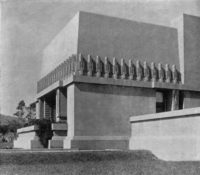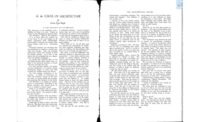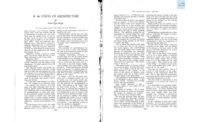From Architectural Record, May, 1914. Read a PDF of the original article here.
Note – In connection with the exhibition at the Chicago Art Institute of the Chicago Architectural Club during April and May, there will be an individual exhibit by Frank Lloyd Wright of the work done by him since his return from Europe. Some of the subjects shown will be drawings of the New Imperial Hotel at Tokio, the Midway Gardens at Chicago, Lake Geneva Hotel, The Coonley Kindergartens, about fifteen residences, also models and plates of the twenty-five story building in San Francisco, The Coonley Play House and the Midway Gardens and details of furniture and special features of the building. The exhibit itself is to be in a separate room and installed in a characteristic manner. This second paper by Mr. Wright is a timely supplement to the very notable exposition of the artist motives actuating his work, which appeared in the Architectural Record in March, 1908. – Editor.
“Nature has made creatures only; Art has made Men.” Nevertheless, or perhaps for that very reason every struggle for truth in the arts and for the freedom that should go with the truth has always had its own peculiar load of disciples, neophytes and quacks. The young work in architecture here in the Middle West, owing to a measure of premature success, has for some time past been daily rediscovered, heralded and drowned in noise by this new characteristic feature of its struggle. The so-called “movement” threatens to explode soon in foolish exploitation of unripe performances or topple over in pretentious attempts to “speak the language.” The broker, too, has made his appearance to deal in its slender stock in trade, not a wholly new form of artistic activity certainly, but one serving to indicate how profitable this intensive rush for a place in the “new school” has become.
Just at this time it may be well to remember that “every form of artistic activity is not Art.”
Obviously this stage of development was to be expected and has its humorous side. It has also unexpected and dangerous effects, astonishing inline with certain prophetic letters written by honest “conservatives” upon the publication of the former paper of 1908.
Although an utterance from me of a critical nature is painful, because it must be a personal matter, perhaps a seeming retraction on my part, still all that ever really happens is “personal matter” and the time has come when forbearance ceases to be either virtue or convenience. A promising garden seems to be rapidly overgrown with weeds, notwithstanding the fact that “all may raise the flowers now, for all have got the seed.” But the seed has not been planted – transplanting is preferred, but it cannot raise the needed flowers.
To stultify or corrupt our architectural possibilities is to corrupt our aesthetic life at the fountain head. Her Architecture is the most precious of the susceptibilities of a young, constructive country in this constructive stage of development’ and maintaining its integrity in this respect, therefore, distinctly a cause.
When, twenty-one years ago, I took my stand, alone in my field, the cause was unprofitable, seemingly impossible, almost unknown, or, if knowns, was, as a rule, unhonored and ridiculed – Montgomery Schuyler was the one notable exception to the rule. So swiftly do things “come on” in this vigorous and invigorating age that although the cause itself has had little or no recognition, the work has more than its share of attention and has attracted to itself abuses seldom described – never openly attacked – but which a perspective of the past six years will enable me to describe, as I feel they must render the finer values in this work abortive for the time being, if they do not wholly defeat its aim. Many a similar work in the past has gone prematurely to ruin owing to similar abuses – to rise again, it is true, but retarded generations in time.
I still believe that the ideal of an organic* architecture forms the original and source, the strength and, fundamentally, the significance of everything ever worthy the name of architecture.
And I know that the sense of an organic architecture, once grasped, carries with it in its very nature the discipline of an ideal at whatever cost to self-interest or the established order.
It is itself a standard and an ideal.
And I maintain that only earnest artist integrity, both of instinct and of intelligence, can make any forward movement of this nature in architecture of lasting value.
The ideal of an organic architecture for America is no mere license for doing the thing that you please to do as you please to do it in order to hold up the strange thing when done with the “see-what-I-have-made” of childish pride. Nor is it achieved by speaking the fancied language of “form and function” – cant terms learned by rote – or prating foolishly of “Progress before Precedent” – that unthinking, unthinkable thing! In fact, it is precisely the total absence of any conception of this ideal standard that is made conspicuous by this folly and the practices that go with it. To reiterate the statement made in 1908:
This ideal of an organic architecture for America was touched by Richardson and Root, and perhaps other men, but was developing consciously twenty-eight years ago in the practice of Adler & Sullivan, when I went to work in their office. This ideal combination of Adler & Sullivan was then working to produce what no other combination of architects nor any individual architect at that time dared even preach – a sentient, rational building that would owe its “Style” to the integrity with which it was individually fashioned to serve its particular purpose – a “thinking” as well as a “feeling” process, requiring the independent work of true artist imagination – an ideal that is dynamite, cap and fuse, in selfish, insensible hands - -personal ambition, the lighted match.
At the expiration of a six year apprenticeship, during which time Louis Sullivan was my master and inspiration, twenty-one years ago, I entered a field he had not, in any new spirit, touched – the field of domestic architecture – and began to break ground and make the forms I needed, alone – absolutely alone.
These forms were the result of a conscientious study of materials and of the machine which is the real tool, whether we like it or not, that we must use to give shape to our ideals – a tool which at that time had received no such artistic consideration from artist or architect. And that my work now has individuality, the strength to stand by itself, honors Mr. Sullivan the more. The principles, however, underlying the fundamental ideal of an organic architecture, common to his work and to mine, are common to all work that ever rang true in the architecture of the world, and free as air to any pair of honest young lungs that will breathe deeply enough. But I have occasion to refer here only to that element in this so-called “new movement” which I have characterized by my own work and which should and, in a more advance stage of culture, would be responsible to me for use or abuse of the forms and privileges of that work. Specifically, I speak only to that element within this element, not beyond private reach or control, ruthlessly characterizing and publicly exploiting the cause it does not comprehend or that it cannot serve.
Some one for the sake of that cause must have some conscience in the matter and tell the truth. Since disciples, neophytes and brokers will not, critics do not, and the public cannot – I will. I will be suspected of the unbecoming motives usually ascribed to any man who comes to the front in behalf of an ideal, or his own; nevertheless, somehow, this incipient movement, which it has been my life work to help outfit and launch, must be protected or directed in its course. An enlightened public opinion would take care of this, but there is no such opinion. In time there will be; meantime good work is being wasted, opportunities destroyed or worse, architectural mortgages on future generations forged wholesale: and in architecture they must be paid with usurious interest.
* By organic architecture I mean an architecture that develops from within outward in harmony with the conditions of its being as distinguished from one that is applied from without.








Post a comment to this article
Report Abusive Comment